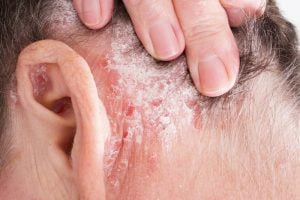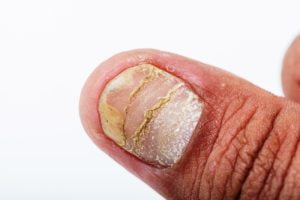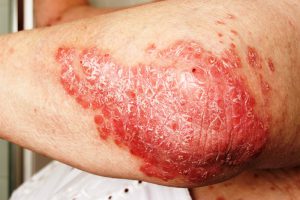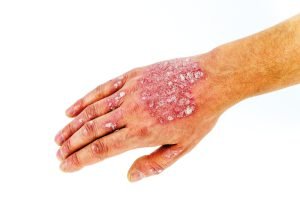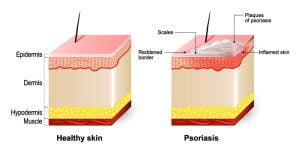Browsing: Psoriasis Graphics
Comprehensive Information, Resources, and Support on Psoriasis
Psoriasis common sites: It tends to be more common at sites of friction, scratching, or abrasion. These patches or plaques most often occur on the scalp, knees, elbow and lower back. Although, the symptoms of psoriasis can occur on the skin anywhere on the body but the most common places where psoriasis symptoms develop are elbows and knees, face, hands and feet (palmoplantar psoriasis), nails, genitals, soft tissue inside your mouth, armpit, fingertips, etc.
Skin lesions, or plaques due to psoriasis most often develop on the scalp, knees, elbows, lower back and feet. They are generally itchy and painful, and can crack and bleed. The size of plaques may vary. They appear as distinct patches or as joined together covering a large surface of your skin.
Psoriasis vulgaris is a psoriatic skin disease which causes skin patches to develop that are typicaly red, itchy, and scaly, as shown in the picture. It is the most common type of psoriasis affecting approximately 90% of its patients. It is also known as plaque psoriasis. Skin affected with plaque psoriasis is generally very dry, and other possible symptoms include skin pain, itching and cracking. These plaques are raised irregular to oval in shape collection of dead cells. This disease is referred to as an inflammatory infectious disease.
Many people with psoriasis develop nail changes, such as pitting, nail bed separation, and changes in color. Psoriasis can affect both fingernails and toenails. The percentage of people with psoriasis who have nail-related symptoms is about 50%. In many cases, psoriatic nails might loosen and then separate from the nail bed (onycholysis). In some cases, psoriasis may cause the nail to crumble while in the other, nail plate looses the cells and forms small pits in it.
Psoriasis is a common skin condition that increases the life cycle of skin cells. It causes cells to build up fast on the surface of the skin. The extra skin cells form scales and red patches that lead to itchiness and pain. Psoriasis occurs due to overactive immune system and the symptoms include flaking, inflammation, and thick, white, silvery, or red patches of skin. Scales typically develop on joints, such elbows and knees. They may develop anywhere on the body, such as on hands, feet, neck, chest, scalp or even on face.
Plaque psoriasis (also called psoriasis vulgaris) is the most common form of psoriasis and usually produces plaques of red, raised, scaly skin affecting mainly your scalp, elbows, and knees. This can last for weeks or months. Plaques vary in size but are generally of round shape with irregular borders. In a study, it was estimated that about 1 in 3 people had patches of plaque psoriasis on their knees. Due to the position on joints of the body, they tend to form small cracks form in the dry, thickened skin. These cracks are known as fissures which are painful and can bleed in some cases.
Psoriasis on hands and feet can be difficult to treat. If you have an acute psoriasis flare-up on your hands or feet
When the underlying cells reach the skin’s surface and die, their volume causes sumptoms to develop in the form of raised, red plaques covered with white scales. Psoriasis generally affects your knees, elbows, and scalp, but it can also affect the torso, palms, and the feet.
ADVERTISEMENT






